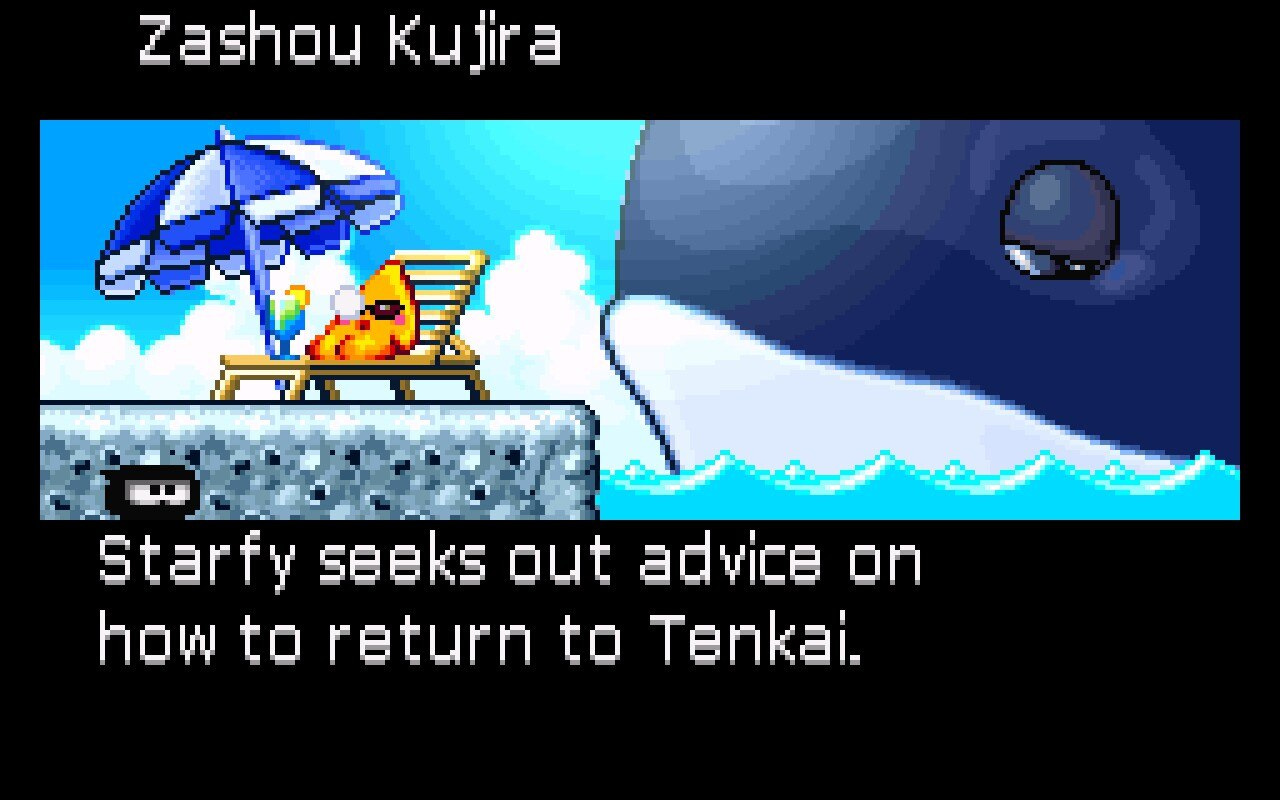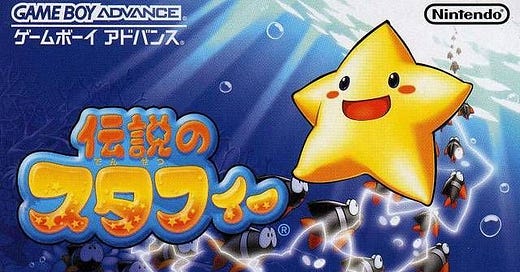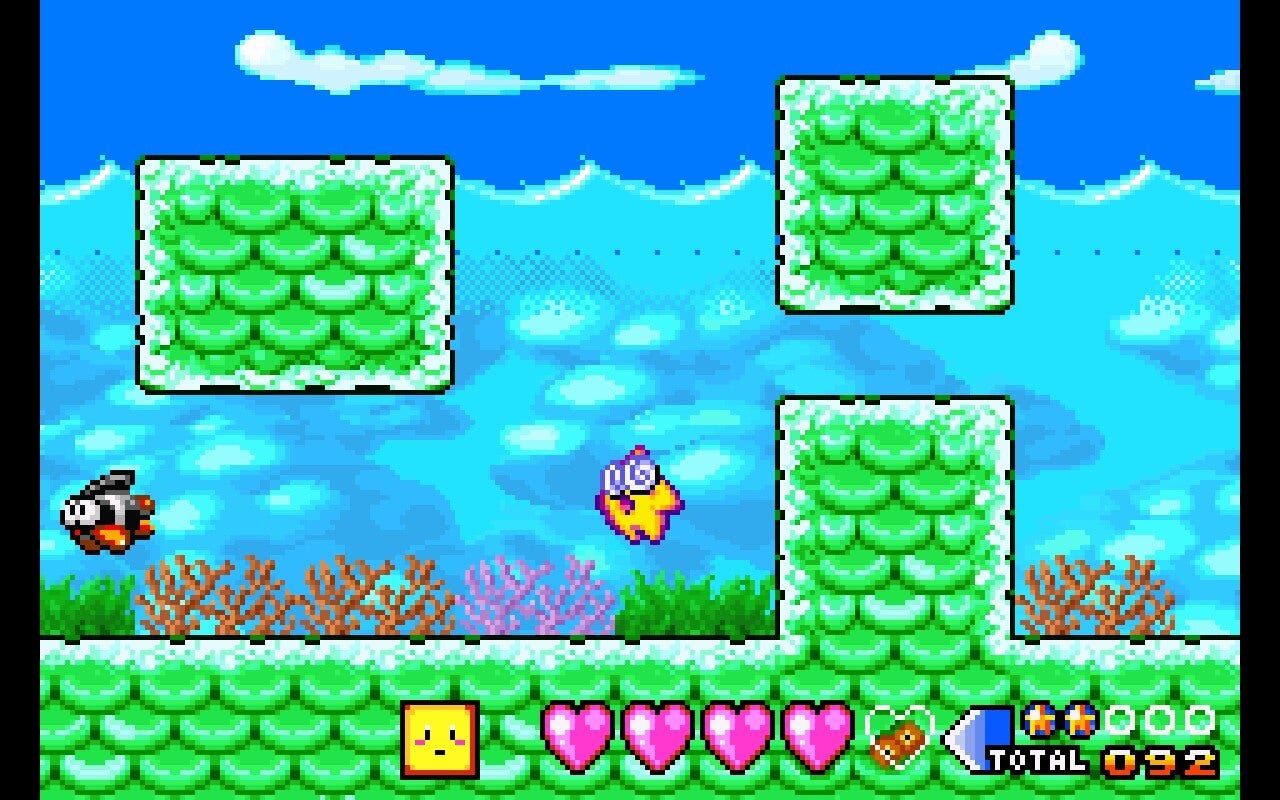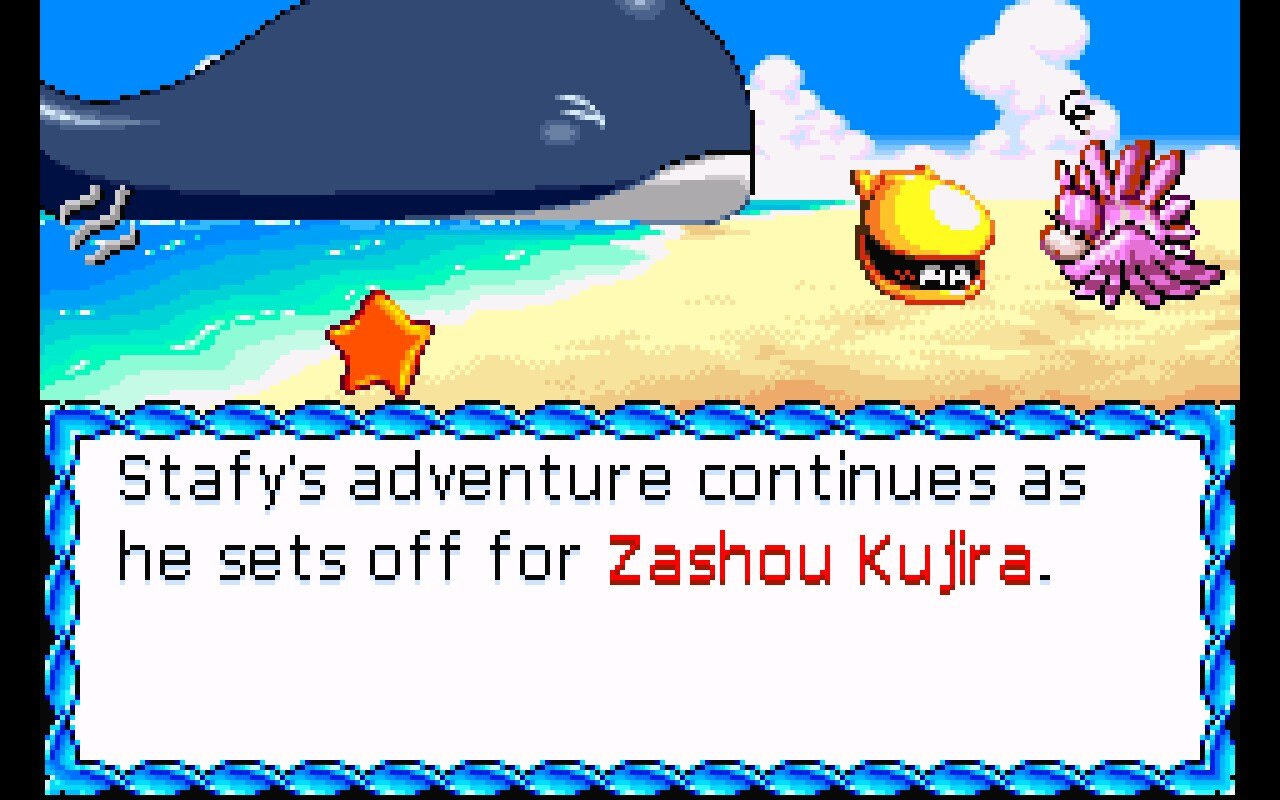Past meets present: Densetsu no Stafy
The first game in what North Americans know as The Legendary Starfy series finally left Japan.
This column is “Past meets present,” the aim of which is to look back at game franchises and games that are in the news and topical again thanks to a sequel, a remaster, a re-release, and so on. Previous entries in this series can be found through this link.
In the summer of 2009, The Legendary Starfy debuted in North America. It was a game for the Nintendo DS, published by Nintendo and developed by Tose, in one of the rare instances where no digging was necessary to discover the latter fact. Tose, which has been a “ghost developer” of sorts for decades now, claimed they had worked on over 1,000 games during a 2007 interview with Game Developer, and most of them were uncredited, hence the “ghost” designation — that number is obviously higher now, 17 years later.
The Legendary Starfy, though, was always a co-production between Nintendo and Tose, not one that came out of Nintendo giving Tose a contract to develop a game in an established series or a port or what have you. Instead, this was the two companies working together on something they both had a copyright stake in, with a producer at Tose — Yasuhiro Minamimoto — being the one to reach out to a producer at Nintendo — Hitoshi Yamagami — to start thinking about how to make a “floaty platformer.” Yamagami had co-created Panel de Pon for Nintendo, and was also a manager for games created by outside developers, with Tose being one such studio. (Yamagami is also the producer who approved the pitch for Monolith Soft’s Xenoblade Chronicles, and then extended the game’s development timeline when it was needed, after years of Namco pushing the studio to hurry things along and cut content with the Xenosaga trilogy. That all seemed to work out well for Nintendo and Monolith.)
Except the game Yamagami and Minamimoto discussed together didn’t release in 2009. It came out in 2002, and only in Japan, for the Game Boy Advance. The Legendary Starfy, as it is known in North America, was actually the fifth entry in the series, and the second game to release on the DS. The first one was titled Densetsu no Stafy, which makes things a bit confusing in the present since it would have been translated to The Legendary Starfy or The Legend of Starfy or something along those lines had it been brought to North America shortly after its release instead of over two decades later, but instead, that’s the title that went to the fifth entry.
Starfy is the protagonist of the series, but despite the appearance and the name, he is not a starfish. At one time, early in development — like, early, as Tose and Nintendo began discussions for this game in 1995, and worked on prototypes for the Game Boy and Game Boy Color before the Game Boy Advance finally brought this saga to a close — he was an anthropomorphic starfish. The star of a “floaty” platformer set where the most floating could happen: underwater. According to Tose, now, he is neither a starfish nor a star, despite falling out of the sky. He’s just “the prince of Pufftop,” though, Pufftop was a localization choice: he was the prince of Tenkai in Densetsu no Stafy, a kingdom in the sky, but not out in space.
Also, Starfy is naked. They don’t tell you that, but once you visit Tenkai and see that his parents are dressed in royal finery and there are full body outfits for the castle guards and it’s only the tiny children that also have no clothes on, you realize that Starfy is naked throughout Densetsu no Stafy. Once you see it, there’s no unseeing it, like when you’ve gazed upon a shoeless Kirby, or realized Donald Duck is only wearing a shirt and no pants. Maybe Nintendo was worried about coming up against Moms Against Gaming, so they just kept the series in Japan rather than make Starfy put some swim trunks on.
More seriously, the concern was Nintendo of America’s annoying constant: Densetsu no Stafy was simply too Japanese for American audiences to understand, so why bring it over? In a Q&A with Yamagami and Minamimoto that took place to promote The Legendary Starfy, the two said as much to Nintendo Life’s Colby Dillard: “…they had long wanted to bring the Starfy titles to America, but that Nintendo of America had always thought the games were a bit too Japanese for a release outside of Japan.” Between the success of Densetsu no Stafy 4, however, combined with the worldwide domination of the DS, Nintendo of America was forced to relent. The Legendary Starfy didn’t exactly dominate the charts, but being able to combine sales in Japan with overseas sales helped make up for some of that. Not enough to bring on a sixth game in the series, but you can’t have everything.
In July of 2024, Nintendo dropped all three of the Game Boy Advance Starfy titles on Nintendo Switch Online’s GBA app. They’re untranslated, which is a shame, because the personality of the characters and the gags in the game add quite a bit to the proceedings. The gameplay is strong, but not as strong as something like Kirby, which it’s often likened to because they are both (1) cute and (2) not terribly demanding and therefore suitable even for less experienced players, so it’s the complete package that makes it work. Which means that, if you can’t read the game’s text and many skits and jokes and bits, it’s not going to be as enjoyable as it should be. Luckily, there is a completed unofficial translation available, which has had the bugs patched out of it at this point, and contains just a few typos spread across the whole thing as of September 2023’s update, instead of a noticeable amount of them. Meaning, there are ways for you to enjoy the game as it was meant to be enjoyed, if you care to put in a little bit of effort yourself. A practice that pays off, I can assure you.

You’ve got quite a bit going on in Densetsu no Stafy, though. Don’t take the fact it’s very approachable and open about that and misconstrue it as boring. You dash! You swim! You have multiple spin attacks! You can glide in midair, and moving about on land is notably different from moving underwater; you’ll have to master both styles. While most platformers have water sections, and those can, at times, be a bit of a drag compared to the rest of the game, Densetsu no Stafy sets most of its runtime underwater or around it, and revels in what that allows you to do. Swimming is not a ponderous or dangerous thing here, so much as it’s freeing: Starfy can dash on land and cannot in the water, sure, but he’s otherwise much more difficult to control, a fish out of water, as it were, whereas movement under the sea is fluid, it’s smooth, it feels so much more natural here. It took Tose and Nintendo ages to iron out just what Densetsu no Stafy would be and how it would feel, but they nailed it in the end.
Here’s the game’s setup: Starfy is the prince of Tenkai/Sky World/Pufftop, whatever you want to call it at this point. He’s a bit of a klutz sometimes, and accidentally ends up dropping a jar containing an evil unkillable monser that’s been trapped away for ages to the world below, with him dropping after it. You spend the game’s eight stages trying to make it back to Tenkai, and then ultimately, in resealing the evil that Starfy whoopsed back into existence.
It’s appreciated that, in-game, on land, you can kind of see the whole Starfy isn’t graceful thing. Jumping isn’t like it is in Mario or Kirby, where it all feels right and precise. Here, you are very much trying not to fall. You are trying to make perfect jumps, because you have to. It’s slow going, and Starfy’s eyes bugging out of his head when dashes, when he really adds some haste to his movements on land, adds to the whole vibe of this being a dangerous situation for him, to exert this much effort and display reckless abandon.
Underwater, though, now that’s where Starfy looks and feels at home. He’s not a starfish, no, but he moves underwater like he’s always belonged there, possessing a confidence he simply does not have and does not deserve to have on land. Swim fast and turbo spin into foes by pressing in the direction you want to spin, then keep on swimming. Guide yourself around obstacles, picking up collectibles, ping ponging from enemy to enemy to create combos and bonus pickups in the process, and then end up on land and start crashing into walls and falling off of platforms and such. That’s Densetsu no Stafy [complimentary].
You have five hearts, and they’re refilled one at a time by collecting five pearls. Pearls come in ones and fives, with the latter being much more rare, but they’re often placed after moments where you might have hurt yourself, regardless: sometimes, they’re clearly there just to amass a bunch of them as a collectible, but more often than not there’s a purposeful placement to them to help you along in your mission. Lives and continues are infinite, so health is really just there to keep you humming along without having to restart from a checkpoint, and the pearls are sometimes barely even necessary as a medicine considering that checkpoints/in-level saves also refill your health, and they’re always after and before bigger moments and set pieces. Plus, your health for boss fights and your health for everything else are separate, so, you can roll on into a boss encounter with one heart left, but begin the actual fight with a full set, anyway, and vice versa late-game when you fight multiple bosses in one stage.
You can earn additional pearls by defeating enemies in quick succession using your spin: spin into one foe, and get nothing, spin into two one after another, still nothing, but get that up to four, and you get a second extra pearl. A fifth, and a fiver appears. This is never a necessity, so don’t stress it too much if you struggle to pull it off regularly, but it’s there for you if you want to give it a go. You can’t just spin forever, as there’s a rhythm to chaining these along as a replacement for being able to dash underwater: if you spin too many times in a row too quickly, you’ll dizzy Starfy, and need to wait for him to recover, or, be hit by an enemy to knock him out of it, at the cost of some health. If you get the timing right, however, you can spin pretty incessantly, with small pauses in between. There’s a standard spin, where you just press the button to do the spin, and there’s a more focused turbo spin, where you press in the direction you want to go: this one is a lot harder to control, and will see you ricocheting all over the place at times, but it’s also necessary for breaking some blocks, for using spinning as travel, and for harming some tougher foes.
Densetsu no Starfy is a surprisingly chatty game, especially early, but the interactions tend to be enjoyable, and if you’re not feeling them, you can also just skip them. This is good news, too, if you plan to play on Nintendo Switch Online and can’t read Japanese, as all of it would be lost on you, anyway. Now you can just treat it like a platformer from 1987 or whatever where no one says a word and you just figure everything out from the manual, anyway.
While there are just the eight stages in Densetsu no Stafy, there’s actually more to the game as a whole than that. It’ll take you a little over three hours to see the credits roll, but another few hours to wrap up everything there is to do. First, there are optional and hidden vehicles you can discover throughout the game, which lead you to some bonus rooms full of pearls and new gameplay experiences. Find a vehicle in one stage — like a hot air balloon, or a tank — then in a later one, find the hidden room that lets you utilize that vehicle. The pearls are also for more than health, as collecting them unlocks more and more characters on a piece of artwork that you can view, featuring the cast of the game in what looks like Stafy taking a very complicated selfie.
In addition, after returning the jar to Tenkai — now with the unkillable Ogura back inside — at the end of the game, Starfy and his sidekick, the clam Kyorosuke (or Moe, in The Legendary Starfy), accidentally knock it down again, after an entire vault full of treasure from Tenkai is also knocked down below. You can then replay each of the game’s levels until you find all the treasure and defeat Ogura again, with the 48 treasures hidden behind a number of blocks that, previously, you could not destroy, as they were protected by an evil magic. It’s not exactly fully new, but it’s also not an entire rehash, either, and you can now take your time or choose your play order, as well, with the game switching from a forced linear level-to-level format to the introduction of a map that you make decisions about your next destination on. It still doesn’t make Densetsu no Stafy a super lengthy game, but it doesn’t need to be: 5-6 hours feels pretty good for what’s on offer here, and the second half of that is optional if you’re looking for more game.
A thing that stuck out to me playing through Densetsu no Stafy this last time around — when I was actually able to understand the game’s text — is that it might never have become a global hit or one of Nintendo’s major properties, but it has a clear influence on what I’ll call the indie pixel scene. The sound (the sound, Stafy’s soundtrack is superb in spite of the GBA’s oddities), the look, the humor, the way conversations are slotted in between playing through levels, it all has that same vibe as a high-powered 2D retro indie platformer from the present day. Were Tose and Nintendo simply ahead of the game here, vibe-wise, or have we just moved on to this portion of the retro revival, where a 2002 Japan-only platformer now looks like it belongs right alongside present-day releases going for a very specific vibe and feel?
Regardless of the answer, that the question exists should tell you a little bit about what you’re in for. Densetsu no Stafy has been likened to series like Kirby, as mentioned, but a lot of that had to do with a lack of alternative options to put in Kirby’s place. (Not all of it, though: the two share a love for minigames where the protagonist is used as a ball.) Twenty-two years on, with more of Japan’s history of games widely known than it used to be, and with a modern-day development scene very much pulling from the days of 32-bit pixel adventures, it’s a little easier to see Starfy games for what they are, which is a blend of multiple things in a package that is more common now than it used to be. You can appreciate them for what they are without trying to shove them into a specific box they don’t quite fit in: they’re Starfy games, first and foremost.
Maybe we’ll get lucky, and Nintendo will actually get these things localized in an official capacity and released in a collection, because there’s currently no legal way to experience the games as they were meant to be played: Nintendo Switch Online gets the closest, but again, those releases have been untranslated, with no sign of that stopping in the future.
This newsletter is free for anyone to read, but if you’d like to support my ability to continue writing, you can become a Patreon supporter, or donate to my Ko-fi to fund future game coverage at Retro XP.








Great read as always. I imported the GBA games in 2020 and was determined to play through.a game fully in Japanese as part of my Japanese language learning. I have a large notebook filled (almost entirely from this game) with words I didn't know before playing it. Like the tsubo (jar) or the zashou kujira 🐳 shown above. It was a really meaningful experience in my language learning. The gameplay itself in the first game was surprisingly simplistic but I've played The Legendary Starfy years ago so I know the series gets more.mechanically deep and challenging over time.
The GBA battery was busted or there was some issue with saves, so I had to keep restarting the game and probably replayed the first hour two or three times. I still really enjoyed my experience despite that. For my first game in Japanese I expected the text to be pretty brief, I guess I forgot how chatty the series is, so that was pretty surprising but definitely made for a robust (and adorable) learning experience.
Now that the series is on NSO, I might still stick with my favorite handheld form factor (DS Lite), but it's good to know there's this option if my other imported copies have similar save issues.
I remember getting the DS game having no idea of the series history, enjoyed it but I think the cartridge got messed up due to leaving it in a car pocket. I appreciate that the older games are available at all in an official capacity for us in the U.S, but it'd be nice if they weren't a downgrade from emulating with a translation patch.
Also shout out to Starfy being one of the first assist trophies in Smash Bros, with the gimmick of actually being able to be attacked back later applied as a universal rule, making him ahead of the curve.